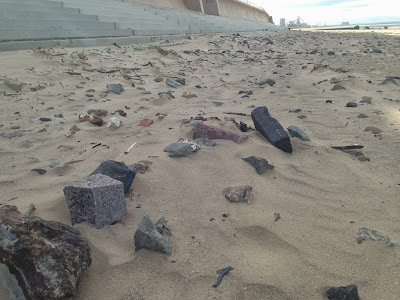Since we began this “crusade” of removing rubble from our beach following the building of the new coastal defences and striving to get the Environmental Agency and Birse to come back to clean up, one of the criticisms we get is that masonry has been on the beach for decades and that no matter how often we remove rubble it will keep coming back.
We disagree. If material does comes back why does it strategically form only along the new defences? If it is cleaned up we don’t believe it would come back in any great volume or size. The rubble that continually is revealed is the stuff that had been buried old and new next to the defences when the new work was built.
So is there old rubble on the beach from previous developments? Short answer to that is YES. Of course there is. We have never disputed that old rubble has been on the beach for years. And it ain’t pretty! There is lots of old rubble of different shapes and sizes, age and variety. However the amount has multiplied drastically since the work, making it all much more noticeable and undesirable.
 There are differences between old and new fabrication that has been exposed to the elements. We have seen so much of it now we could probably start a course on marine rubble. If we had the money to waste we could also examine the varieties and complete an historical survey of the many surfaces that have been used on Redcar's sea front. We haven’t got funds to waste on trivia, but our common sense tells us much of the rubble that is visible, is new.
There are differences between old and new fabrication that has been exposed to the elements. We have seen so much of it now we could probably start a course on marine rubble. If we had the money to waste we could also examine the varieties and complete an historical survey of the many surfaces that have been used on Redcar's sea front. We haven’t got funds to waste on trivia, but our common sense tells us much of the rubble that is visible, is new.Not all of it is broken up concrete either. Some of the rubble is house bricks or different types of paving for example. There’s many difference sizes, style and colours, old and new. Further out away from the sea defences are examples of masonry that have been weathered, eroded and shaped over time by the thrashing of the waves.
 |
| Selection of Redcar beach rubble. Some are shaped from years on the coast. Other pieces are clearly newly formed. |
Commonly formed concrete rubble that has been subjected to the elements for years tends to become darker, often brownish and can be stained with marine growth if static for long enough. It is often shaped and rounded. These examples in Redcar are large boulders that have been in the sea for many years and are 'our' responsibility to remove if we want a beach clean of these eyesores.
 |
| Old stained rubble with kelp accessories not far from the Redcar Beacon |
 |
| Marine life existent on static rubble too heavy to be moved by the sea |
 |
| Browned and ancient rubble on the petrified forest |
 |
| This massive piece is next to the Dundas Street slipway (No it isn't a rock!) |
The new rubble that has recently been formed and which dwarfs what was originally on our beach, looks clean and often reveals reinforced lengths of polypropylene, used on the new and previous development. This stuff is found next to our sea defences and logically can only be from the installation of the new and the demolition of the old sea defences last year (2012). This same material can be seen on the runaway going down to the beach from Dundas Street and on the bottom few steps along the seaward side of the seawall. Closer scrutiny and you can see the identical fibres protruding where the edges have been damaged.
We are asking that the Environmental Agency come back and do a clean of the areas around the sea defences that are littered with masonry. They state they did a thorough clean up and this rubble was either washed in or has always been there. Our answer to that is if they cleaned up properly the old rubble would have gone with this new stuff. We believe lots of this debris was buried and is subsequently being uncovered by the natural shifting of sand and movement of the sea.
If we recognise this as a problem now, we could easily arrange to get this shifted before the next summer season and visitor attraction campaigns begin. We are waiting for a date when the Environmental Agency will invite us along to carry out an inspection and continue to inform Redcar and Cleveland Borough Council of our information and concerns.
Links:
http://friendsofredcar.blogspot.co.uk/2013/09/redcar-flood-alleviation-scheme_27.html
Credits:
Thank you for all the photos. We have many on our system now and will show the many that haven't been published yet. Thanks also to Fred Brunskill for the additional information regarding the polypropylene fibres.







No comments:
Post a Comment
What do you think?